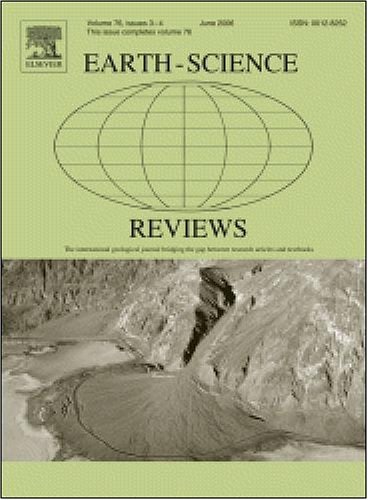Spatiotemporal evolution of aeolian sedimentary landscapes on the southern Tibetan Plateau during the late Quaternary: A review and recent advances
IF 10.8
1区 地球科学
Q1 GEOSCIENCES, MULTIDISCIPLINARY
引用次数: 0
Abstract
The aeolian deposits on the southern Tibetan Plateau (TP) are one of the most important environmental archives preserved at the highest altitudes worldwide, containing extensive information about both the current and past landscapes and environments of Earth's Third Pole. Over the past three decades, these deposits have attracted considerable attention in Quaternary paleoclimate research. Nevertheless, our understanding of these high-altitude aeolian deposits is significantly less than that for similar deposits in the low-altitude regions of the Eurasian continent. To better comprehend this important archive, it is essential to integrate knowledge from various perspectives. However, there is a lack of consensus regarding their formation, distribution, chronology, provenance, and paleoclimatic history across different timescales. Here, based on our recent field investigations and new data, along with previously published data, we present the results of a systematic analysis of aeolian deposits on the southern TP. Our principal results and findings are: (1) We present up-to-date maps of the aeolian deposits, consisting of an overview map of the overall spatial distribution, and six high-resolution regional maps highlighting details of the depositional areas. Loess and sand dunes have accumulated within the six subdomains, following the global pattern of dust accumulation along rivers in arid and semi-arid regions. (2) Based on paleomagnetic and ESR dating, the oldest aeolian sediments were formed during the middle Pleistocene. The probability density of 220 OSL and AMS 14C ages reveals that 98.7 % of the young sediments accumulated since the last interglacial, with the majority (66.4 %) forming during the Holocene. A comparison of age clusters with records of ice volume, temperature, precipitation, vegetation, and paleolakes revises previous hypotheses regarding the factors influencing dust deposition, emphasizing the dominant control of climate change. (3) The aeolian sediments are of local origin and their sources remained relatively stable over time. Quantitative analysis of 48 samples using geochemical fingerprinting showed that the aeolian sediments are a mixture of various clastic materials derived from upstream areas, with the predominant contribution from sand dunes (58.7 %). (4) We examined the climatic evolution of this region and its driving mechanisms during the middle to late Pleistocene and the Holocene. This analysis suggests that changes in cold and warm season insolation were the primary external drivers of moisture and dust activity on both orbital and sub-orbital scales. The winter mid-latitude Westerlies and the Indian summer monsoon, which are influenced by these seasonal insolation variations, regulated the moisture evolution, while the near-surface winds, primarily driven by cold season insolation and influenced by ice volume and oscillations in North Atlantic climate, played a significant role in modulating dust activity. Accordingly, we present a comprehensive conceptual model to illustrate the theoretical framework of aeolian sedimentary landscapes and their impacts and responses to regional and global climate changes. Overall, this review contributes to an improved understanding of the late Quaternary evolution of dust deposition and the environment on the southern TP.
晚第四纪青藏高原南部风成沉积景观的时空演化:回顾与最新进展
青藏高原南部的风成沉积物是世界上最高海拔地区保存下来的最重要的环境档案之一,它包含了关于地球第三极现在和过去的景观和环境的大量信息。近三十年来,这些沉积在第四纪古气候研究中引起了相当大的关注。然而,我们对这些高海拔风成沉积物的了解明显少于对欧亚大陆低海拔地区类似沉积物的了解。为了更好地理解这一重要的档案,有必要从不同的角度整合知识。然而,对于它们的形成、分布、年代学、物源和不同时间尺度的古气候历史,目前还缺乏共识。在此,基于我们最近的实地调查和新的数据,以及以前发表的数据,我们提出了对南TP风成沉积的系统分析结果。主要成果和发现有:(1)绘制了最新的风成沉积图,包括总体空间分布图和6幅高分辨率区域图,突出了沉积区域的细节。黄土和沙丘在6个子域内积累,遵循全球干旱和半干旱区沿河积尘的格局。(2)古地磁测年和ESR测年表明,最古老的风成沉积形成于中更新世。220个OSL和AMS 14C年龄的概率密度表明,98.7%的年轻沉积物形成于末次间冰期,66.4%的年轻沉积物形成于全新世。年龄群与冰量、温度、降水、植被和古湖泊记录的比较修正了以往关于沙尘沉积影响因素的假设,强调了气候变化的主导作用。(3)风成沉积物具有局地成因,其来源长期保持相对稳定。利用地球化学指纹图谱对48份样品进行定量分析,表明风成沉积物是来自上游地区的多种碎屑物质的混合物,其中沙丘的贡献最大(58.7%)。(4)研究了该地区中晚更新世和全新世的气候演变及其驱动机制。这一分析表明,冷暖季节日照的变化是轨道和亚轨道尺度上水汽和尘埃活动的主要外部驱动因素。受季节日照变化影响的冬季中纬度西风带和印度夏季风调节了水汽的演变,而主要受冷季日照驱动并受北大西洋气候冰量和振荡影响的近地面风对沙尘活动起重要调节作用。因此,我们提出了一个综合的概念模型来说明风成沉积景观及其对区域和全球气候变化的影响和响应的理论框架。总的来说,本文的研究有助于加深对青藏高原南部晚第四纪沙尘沉积演化和环境的认识。
本文章由计算机程序翻译,如有差异,请以英文原文为准。
求助全文
约1分钟内获得全文
求助全文
来源期刊

Earth-Science Reviews
地学-地球科学综合
CiteScore
21.70
自引率
5.80%
发文量
294
审稿时长
15.1 weeks
期刊介绍:
Covering a much wider field than the usual specialist journals, Earth Science Reviews publishes review articles dealing with all aspects of Earth Sciences, and is an important vehicle for allowing readers to see their particular interest related to the Earth Sciences as a whole.
 求助内容:
求助内容: 应助结果提醒方式:
应助结果提醒方式:


